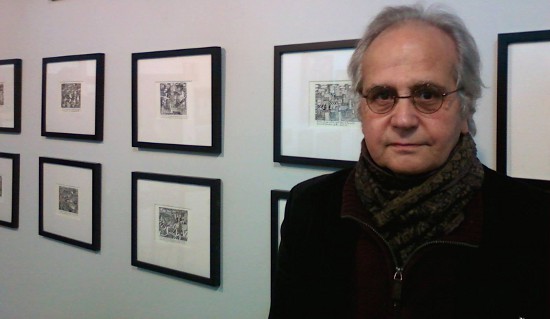
When Bruce de Gouveia Carter died on November 24 at age 66, he left the Quad Cities art community with a gaping hole.
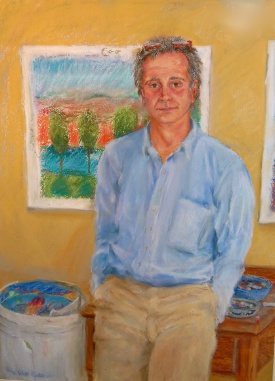 He was a visual artist, a teacher, and an art-store manager. But his largest legacy to the arts community was as a tireless promoter - for more than two decades giving artists of all stripes a forum to discuss their work on his Art Talks radio program on Augsustana College's WVIK and, earlier, St. Ambrose University's KALA. Guests in recent months included mostly visual artists, or course, but also a chef, leaders of the Downtown Davenport Partnership, members of the Bucktown Revue and the Prenzie Players, and a poet. His show was omnivorous in the best possible sense. (WVIK will host a special memorial program for Carter at 7 p.m. on January 15.)
He was a visual artist, a teacher, and an art-store manager. But his largest legacy to the arts community was as a tireless promoter - for more than two decades giving artists of all stripes a forum to discuss their work on his Art Talks radio program on Augsustana College's WVIK and, earlier, St. Ambrose University's KALA. Guests in recent months included mostly visual artists, or course, but also a chef, leaders of the Downtown Davenport Partnership, members of the Bucktown Revue and the Prenzie Players, and a poet. His show was omnivorous in the best possible sense. (WVIK will host a special memorial program for Carter at 7 p.m. on January 15.)
He also wrote art reviews for the River Cities' Reader from 2006 to 2008, and his writing displayed curiosity, openness, insight, intelligence, wide-ranging knowledge, and generosity. That rare combination, presented in approachable yet smart and eloquent prose, amounted to unspoken encouragement to readers: He made you want to visit each show, because he discovered and articulated how the work spoke to him. Like the best critics, he wasn't judging so much as honestly seeing and digesting the art.
Writing about a Les Bell retrospective, Bruce wrote: "In Bell's world, the nude form is an artistic style, a psychological mystery, and a symbol. ... [T]he paintings radiate an intelligent and beautiful atmosphere that immediately takes us beyond the reality of the images. ... Entering the gallery I felt I had stepped into a world of individual stories of psychological relationships, of enigmatic memories, and of the subconscious dreams of the artist."
On an exhibit featuring Rachael Mullins, he began his evaluation with what might construed as a criticism: "At first, Mullins' 14 paintings seem dim and smoky with nostalgia." After writing about several individual works, however, he had unearthed something richer: "Mullins' images produce a kind of quiet, layered music rising and falling, and suddenly surfacing like remembered conversations from the past. Each part of the picture evokes memories and meanings both personal and universal. The accumulation of these layers gives the images a gentle and almost melancholy power. The artist has combined the tensions of longing and freedom, of past and present, of realism and painterly abstraction in each work."
The Reader asked a handful of people who knew Bruce to share their memories of and thoughts about him. Their writing hints at the immense impact Bruce Carter had on the Quad Cities.
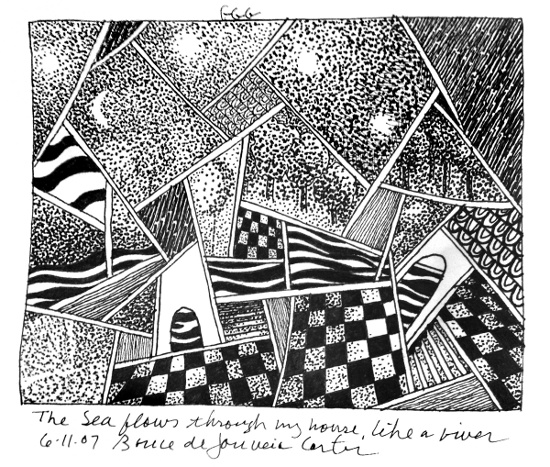
An Enveloping Spirit
"Good evening and welcome. You've tuned in to a conversation between artists. For the next hour we'll be exploring the mind and the creativity of our guest. This is Art Talks, and I'm your host, Bruce Carter."
For more than 20 years, Bruce Carter spoke these introductory words softly over the rhythms of the jazz classic "So What" by Miles Davis for Art Talks, his weekly hour-long show on WVIK, Augustana's NPR station.
The broadcast was a wonderful showcase for area artists. Its success was due largely to Bruce's reassuring manner and his depth of knowledge of art and the art community. He was truly interested in the thoughts of his guests - giving each his whole attention.
I had the pleasure of being a guest repeatedly on Art Talks - first in 1993 and most recently this year. Bruce created a relaxed environment where one could converse openly about one's work - speaking about how ideas are formed, how a style is developed, how one gives back to the community.
Bruce would end the show with a question: "What advice would you give to young artists?"
The question was, really, more important than the guest's answer. It revealed Bruce's desire to teach, to encourage creativity in others. His career as a teacher spanned more than three decades - teaching primarily at Scott Community College, the Figge Art Museum, and Marycrest College.
Bruce was also an artist and poet in his own right. The Sea Flows Though My House, Like a River is just one of his series of small ink drawings on paper that he worked on over the years.
The magic of these postcard-sized artworks is that they open us up to an immense, imaginative journey, formed simply from patterns of nature - the sea, sky, stars, moon, and land woven together with mysterious doorways that feel equally like entrances and exits.
Bruce's artwork was universal. Feeling almost like a shared dream. Yet one also sensed the artist's individual lifetime of experience. "The Sea" could be his spiritual source, the "River" the Mississippi or the Amazon. He lived near both during his life.
Bruce imbued these and his colorful pastels with a gentle spirit. Perhaps it is better to say that he made an enveloping spirit visible for the rest of us. He revealed hidden rhythms and connections that we realized were there all along after they were pointed out to us through his work.
Before his guests would leave the WVIK recording studio when the hour-long conversation concluded, Bruce would pull out a small bag with a drawstring and empty out a handful of glass pebbles, asking his guests to pick one. The first time I was asked, I was puzzled but picked a deep blue one. Over the decades, I came to look forward to this little gift. I never asked Bruce what it meant to him, but, for me, it came to represent a promise to continue to learn and to create.
I just put the last pebble Bruce gave me in a special place.
- Bruce Walters
Bruce Walters is a professor of art at Western Illinois University.
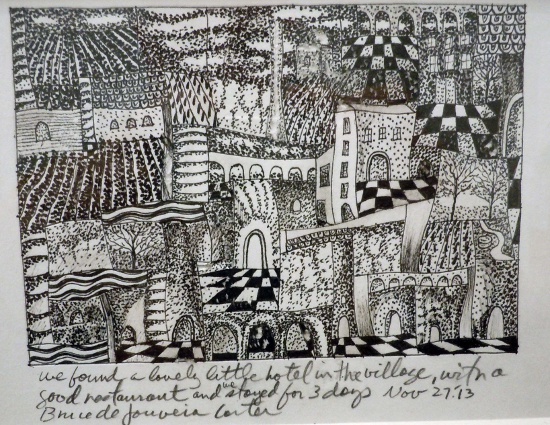
Shaping a Community
I've heard several comedians say that they knew they had "made it" when they were asked to perform on The Tonight Show Starring Johnny Carson and Johnny invited them to sit down and chat with him after their set. As an artist in the Quad Cities area, having Bruce Carter invite you to be on Art Talks was like getting to talk with Carson back in the day.
That invitation was an indication that Bruce had seen (or heard or read) your work and felt that there was enough substance (intellectual activity and creative/productive effort) that you could participate in an hour-long conversation - and it was truly a back-and-forth conversation, about your work, your process, your influences, and your field in general. He listened. He questioned. He helped you define and articulate your thoughts, and if you "got stuck," he'd readily throw you a lifeline. In short, he cared about you. He cared about art. He cared about meaningful discourse.
After the end of your hour on Art Talks, Bruce brought out his little bag of stones and spread them out on the table for you to choose one as a gift; some were shiny, some were blues or greens, others were reds and pinks. He was always intrigued by which stone you chose and why. I frequently wondered if he was able to obtain a deeper understanding of who you were through which stone you picked. I have my stones in my studio as happy reminders of spirited conversations with a warm and sincere friend.
I still smile thinking about the first time Bruce offered me a mint from his pocket full of mints. I thought: "Is he saying I have dragon breath? Is it so foul that I'm gonna make him gasp on-air? What's the deal here?" But that was classic Bruce Carter just offering a "little pick-me-up" to brighten your day. Seriously, the next time you find yourself feeling a little down, have a mint. See if that doesn't improve your mood. Bruce brought people up with kindness and generosity.
Bruce Carter had a gentle demeanor to him that flowed into his artwork. Big, Brash, and Bombastic were not the things that drove Bruce to create. His work was inspired by nuances of color, the gentle flow of the landscape, the quiet conversation between earth and sky, and the sublime moments sitting quietly at a café.
Nestled in the Artists First show (on display through January 11) on the fourth floor of the Figge Art Museum, you'll find We Found a Lovely Hotel in the Village ... , an excellent example of Bruce's oeuvre. It's a small work that comes across with the spontaneity and intimacy of an ephemeral experience captured in an artists' sketchbook. The relatively high-contrast pen-and-ink drawing explores the dense repetitions of buildings, windows, archways, terracotta roof tiles, and rows of planted crops observed while traveling abroad. In the hands of a different artist/soul, these "ingredients" would be the recipe for the visual equivalent of a frat-house food fight. But in classic Bruce Carter fashion, he created a meditative and pleasing visual experience utilizing Cubist space.
Bruce will be sorely missed by the art community here. It's a community he helped shape and nurture through his warm smile, thoughtful discourse, generous nature, keen insights, and sublime artwork. Thank you, Bruce.
- Steve Banks
Steve Banks is a local area artist and occasional contributor to the River Cities' Reader. His hobbies include eating, napping, and listening to the Scorpions.
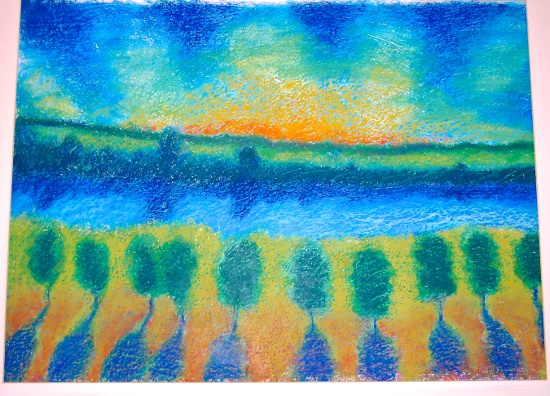
The Godfather of Art
Already, I miss my friend; his absence is just now sinking in ... .
Bruce was one of those friends whom you might not see every day or even every month, but when you did get together, you picked up your conversation where you had last left off. He was that kind of person.
I first met him when he came to the Quad Cities to teach at Marycrest. A fellow educator. I would run into him at art events, and when the school went belly-up I would see him at his various places of employment.
It was when he started at Dabney Decorating as assistant manager that I would see him regularly. One of my former students had put my name and number in the store's Rolodex as "The Suicidal Artist's Hotline." And Bruce would call with questions about art materials that he could not answer. This is where I found out that he was a secret Firesign Theatre aficionado, and he could quote whole bits of their routines. All it would take was just a short phrase, and off he would go. Since I also had been a student of their work and had underground tapes from San Francisco, we had something more in common than art and art supplies.
Bruce was a trusted critic, too - one of the few people whose opinion I trusted. But it was a two-way street, since he would ask my opinion about his current work and we were brutally honest in our comments about each other's work and what we were doing.
When Dabney Decorating morphed into Dick Blick and Bruce took the job of manager, I was spending so much time at the store that he wanted me to come work there! The whole reason for the attention to what was going on down there was self-protection for my students; I wanted them to have a reliable source for their required materials, and that was Bruce.
At the same time he had begun his radio program Art Talks on KALA-FM at St. Ambrose, and he asked me to be nearly his first guest on the program. (Ironically, I was his last guest on his final program in November.) We never planned any program or interview; he would just ask, "What have you been up to, Mr. Bill?" and let me go. A couple of the interviews at KALA-FM he just let me ramble on and walked out of the studio to get a cup of coffee!
When he switched over to WVIK, we continued the program over there. During pledge week he cooked up the idea of "Stump Mr. Bill," where he would ask me obscure art questions that he dug up a couple of weeks before. We had so much fun that we forgot to give the phone number for call-in pledges, so we were asked to stop that idea.
At Christmas several times, Bruce, other members of WVIK staff, and I would read Christmas stories in his Art Talks hour, He would read The Polar Express and I would read "A Child's Christmas in Wales" and Gary Burlingame would read a story by Pearl Buck. We finally had to stop it, as the stories got too long and we kept running into the next hour.
He came up with the idea of teaming the late Jim Konrad with me to do a program he called "Tool Time with Bill & Jim," where we would talk about making artist's tools - which both Jim and I had been doing for some time. But we always ended up with Jim talking about his methods of making charcoal, which included roasting hot dogs over the fire at the same time and me going on about making pastels by hand and finding out that it was cheaper than store-bought versions of the same materials.
We worked together on the Riverssance festival for several years. Although he always attended the meetings, regularly he groused about "hanging around while all we talked about were porta-potties!" He always found a good judge for the show and was primarily responsible for the selection of the artist to receive the yearly Harley award for a lifetime achievement in art. I keep thinking it was about time for him to be the recipient of that award for being the "Godfather of Art" in the Quad Cities region.
He would understand: "Okay, Bob, squeeze the wheeze!" and "Hey, man, he broke the president!" That is, if he were still with us ... .
- Bill Hannan
Bill Hannan taught at Black Hawk College for some 30 years in the Art Department. For 22 years, he was involved with the Genesius Guild in Rock Island in many capacities. He is an award-winning calligrapher, bookbinder, and illustrator. He retired from teaching 14 years ago. He now continues his "other" job as full-time artist, calligrapher, and bookbinder.
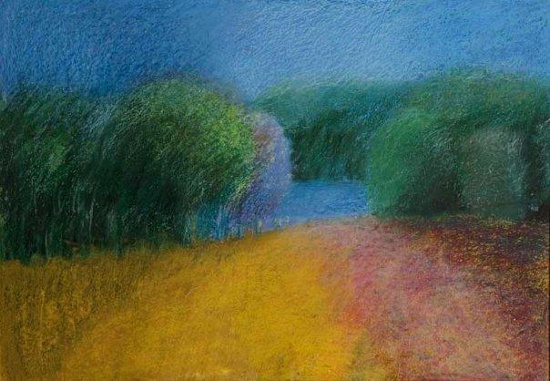
Chasing Away Shadows
I met Bruce de Gouveia Carter upon starting graduate school at the University of Iowa, when Bruce was further along on his printmaking MFA. We frequently chatted at a shared bus stop. He was the first artist - in fact the only artist - who welcomed me to the Art & Art History program. Already, he set an example as a warm personality who was not too cool to reach out to others.
It was a happy circumstance to re-encounter Bruce when I moved to the Quad Cities several years later. At the time he was teaching art at Marycrest College. Bruce did not have an easy career path because at times his employers changed directions. When Marycrest was sold, he transitioned from teacher to art-store manager, still in the business of nurturing creativity. He had coffee ready, along with the best advice and offers for your art-purchasing needs. My daughter thinks of him as "Dick Blick Bruce." When the store closed, Bruce reassured me that it would all work out. Ultimately, he was hired to teach for Eastern Iowa Community Colleges, where he was recognized in 2012 for distinguished teaching.
In addition to making his own art and regularly attending receptions, Bruce engaged in various art-support activities: writing articles, broadcasting, teaching at the Figge Art Museum, steering MidCoast Fine Arts for the Riverssance awards, and generally encouraging creativity. He also exhibited his work, including entering the annual Rock Island Fine Arts Exhibition. I remember the inclusion of his glowing oil-pastel landscapes. His imagined spaces were cerulean blues overspread with warm yellow sunlight that chased away shadows. Those drawings seem to have been a metaphor for his personality.
Bruce had an unusual lilt to his breathy voice, and he loved to use it in his longstanding WVIK radio program Art Talks. In addition to appearing on the program myself, I brought in many other artist guests, and they always reported back how at ease Bruce made them feel. That hour taping flew by. At the end of the interview, Bruce always asked what advice you had for artists just beginning their careers. The summation of the program was to help other artists.
When you finished a friendly encounter with Bruce, he often would pull out his bag of glass tokens, little pats of glass, and urge you to choose and take your favorite one as a memento of your interaction. It was a moment of indulgence and it felt special. I have a garden path dotted with those tokens of pleasant conversations and encouragement. What do those glass pats say to us now? They instruct us to pay it forward, to find, like Bruce, ways to be supportive of others in our creative endeavors.
- Sherry C. Maurer
Sherry C. Maurer holds an MFA in painting, an MA in art history, and a BFA with a printmaking concentration. She teaches art appreciation at Black Hawk College and is building coordinator for the Bucktown Center for the Arts.
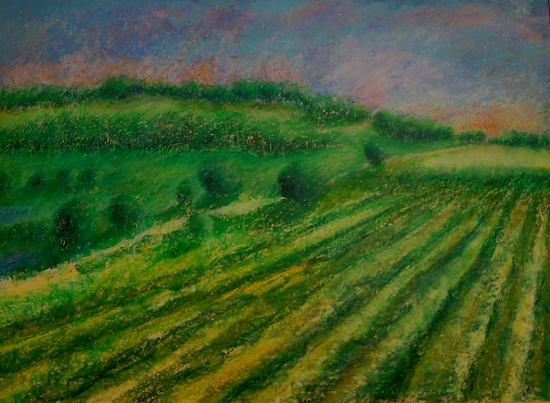
Exploring the Creative Process
I have always found it a little intoxicating to be in another artist's studio - the mix of order and chaos, method and madness, direction and openness that always exists in those spaces along with unfinished work that is full of potential.
I think Bruce Carter found it equally intoxicating to be in someone's mental creative space, and to explore evidence of those same qualities there. He loved to explore your creative process by pointing you in some sort of direction with questions or suggestions, not knowing what you were going to reveal.
I'm not sure where I even met Bruce for the first time - likely, it was either at Dick Blick when it was still on John Deere Road in Moline, at KALA in the early '90s, or at an event sponsored by the Kanga Collective. It was always fun and funny discussing art, design, and music with Bruce, either at an event in Davenport or Rock Island, on-air, or at Dick Blick when he was the manager there. We'd have great discussions every time I went to the store for supplies, and he would always have some new art material or tool to recommend.
I remember once dropping off a CD that I assembled for a drawing class that I was in at the University of Iowa; it was all songs about the process of art-making, and Bruce immediately tuned into my idea and started offering more suggestions every time I would see him. He loved the connection between music and art, and in conversation would often compare the two.
Being on-air with Bruce was pretty much the same as running into him at an art event, because the conversation would be about linking a wide range of topics together, a discussion about how the creative part of your mind worked, and usually putting it somehow in the context of art history.
Many funny moments developed during those radio programs; one time he asked Steve Banks if he used archival materials, which was funny because Steve often uses materials such as discarded T-shirts, cardboard, old jeans, and duct tape. We agreed that he would probably use archival materials if they happened to be in the dumpster he was raiding. Laughter ensued.
I recently heard Don Wooten explain how Bruce's soft, low FM voice was barely audible in his early days at WVIK, because he was forced to wear headphones. He graduated to his later setup of the Pressure Zone Microphone in the middle of the table, which made the whole setup very friendly, and if you closed your eyes, you could almost imagine yourself at an outdoor café somewhere with a cup of coffee, having exactly the same conversation.
I did many programs at WVIK alone or with Steve Banks, and we invited many others who were exhibiting with us to join us on-air, and Bruce put them all surprisingly at ease during their first times recording and talking about their process. He had a kindness and compassion that encouraged people who had never been in that situation to speak comfortably, and he would give them direction if they were being too quiet, or move on quickly if he thought we had veered into some troublesome territory. I sensed his awareness that he was the gatekeeper between the conversation of artists (which can turn obscure or profane in an instant) and the radio audience. He had a great instinct for when he needed to offer some conversational stimulation, and when he should just listen and let the discussion go unfettered.
It was also interesting discussing the art-making process with Bruce, because we had both gone to the University of Iowa and were familiar with the same cast of characters, faculty-wise, who had been there for several decades. It was truly fun and enlightening to have someone with so many points of reference that you could use to frame discussions of art, design, and music. As an artist, you are really lucky if you have perhaps a dozen people from the same specific cultural background of time and place to really connect with, and Bruce was one whose dialogue I always treasured - if it was on the air, between songs at a concert, or at some art event in the Quad Cities, be it within the massive modernist walls of the Figge or in a recycled gallery space up a few flights of rickety stairs in a musty, rusty building in downtown Davenport.
- Terry Rathje
Terry Rathje is a local artist who builds sculptural objects, text pieces from found materials, and temporary architecture. Currently, he is part of a show titled Pro-Text: When Words Enter Visual Art at the Illinois State Museum in Chicago. He is also a professor of graphic design at Western Illinois University, and has been on Art Talks many times over the last two decades, discussing solo exhibitions as well as group and collaborative shows in the area.










